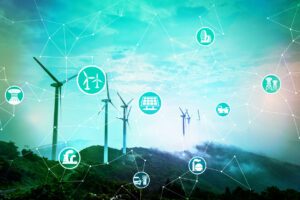
[From the last episode: We looked at the special case of radios and the powerThe rate of energy consumption. For electricity, it’s measured in watts (W). they require in IoTThe Internet of Things. A broad term covering many different applications where "things" are interconnected through the internet. devices.]
That wraps up our energy survey. Let’s take a look back at what we saw over the last few months:
- We finished up our AIA broad term for technology that acts more human-like than a typical machine, especially when it comes to "thinking." Machine learning is one approach to AI. discussion with a look at neuromorphic computing…
- … and the need to label data samples when trainingWith machine learning, a model must be trained in order to perform its function (which is called inference). AI modelsA simplified representation of something real. We can create models of things in our heads without even realizing we're doing it. Technology often involves models because they let us simplify what would otherwise be extremely detailed, complicated concepts by focusing only on essential elements..
- We then looked at the notion of “smart trailers” – industrial IoT in action.
- At that point, we launched into our energy topic, starting by distinguishing energy and power.
- From there, we looked at what it is that’s actually flowing through the electric wires.
- We then looked at the first part of ICAn electronic device made on a piece of silicon. These days, it could also involve a mechanical chip, but, to the outside world, everything looks electronic. The chip is usually in some kind of package; that package might contain multiple chips. "Integrated circuit," and "IC" mean the same thing, but refer only to electronic chips, not mechanical chips. power: what it looks like when nothing is happening.
- And then the second part: what it looks like when the circuit is doing things.
- We then looked a couple of surprising things, starting with the fact that transistors aren’t really off when we think they are…
- … and then the fact that current can sometimes flow through a barrier that we would think would stop it.
- We then looked at how analog circuits affect power.
- We then saw that the supply voltage affects power…
- … and how the transistor threshold affects power…
- … and why building circuits that stay below threshold is possible but hard.
- We then turned to frequency’s effect on power, starting with understanding the role of a clock…
- … and how that clock frequency affects power.
- We then saw that reducing power doesn’t always lower our energy
- Then we explored how we can change voltagesVoltage is what gets electrons to flow. It's analogous to water pressure, which gets water to flow. Voltage is measured in units of "volts." and types for IoT devices, starting with a review of AC and DC
- We then saw how we can convert the AC from the wall into DC for our devices…
- … and how we can change one voltage to another voltage.
- We rounded out the discussion by looking at how we can charge batteries wirelessly…
- … how we can get energy from our surroundings…
- … and the special role that radios in IoT devices play when using energy.
So… where next?

Leave a Reply